I·O·M DOLICHENO:
to JUPITER, BEST and GREATEST, of DOLICHE
Teshub/Tarhun ·
Ba‘al Hadad ·
I·O·M Heliopolitanus ·
Junon Regina Dolichena ·
Castores ·
Sun, Moon, and Eagle
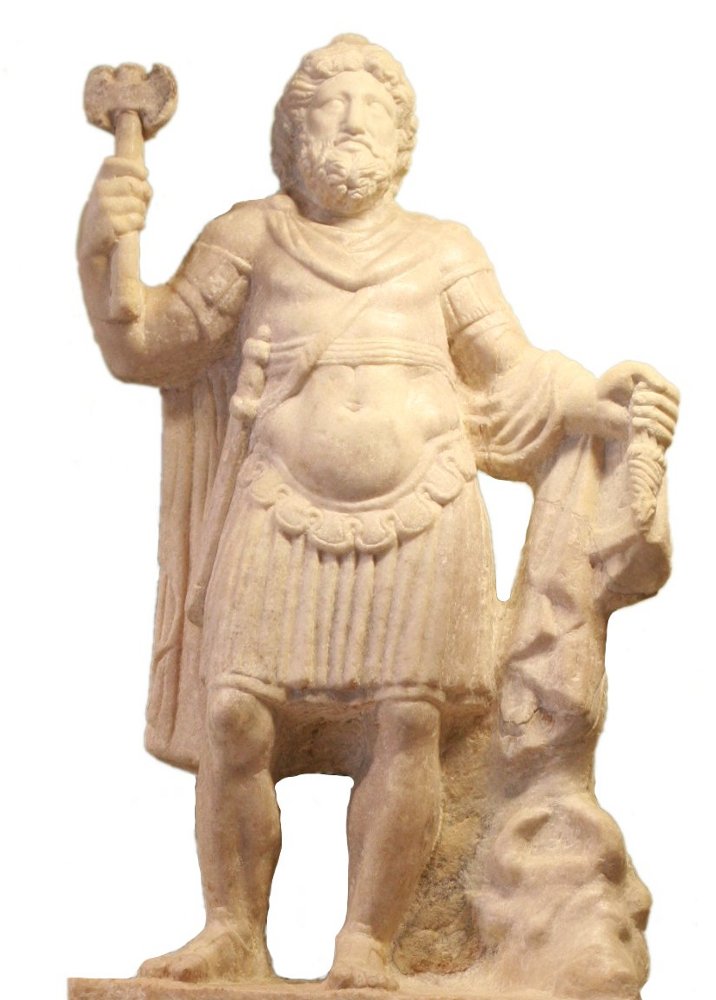 Depiction of Jupiter Optimus Maximus Dolichenus as a triumphant emperor, a double-headed axe in his right hand, a thunderbolt in the left. A bull—the god’s usual steed—can here be seen at his feet, apparently defeated or resting.
(Museum Carnuntinum, Carnuntum ; modification of an image by Matthias Kabel, Creative Commons licence)
Depiction of Jupiter Optimus Maximus Dolichenus as a triumphant emperor, a double-headed axe in his right hand, a thunderbolt in the left. A bull—the god’s usual steed—can here be seen at his feet, apparently defeated or resting.
(Museum Carnuntinum, Carnuntum ; modification of an image by Matthias Kabel, Creative Commons licence)
Jupiter of Doliche was the object of the first great ‘oriental’ mystery cult in the Roman world. Before that of Mithras, the cult of Jupiter Dolichenus spread over military and commercial networks from a provincial Syrian borough to all the corners of the Empire. The popularity of Jupiter Dolichenus (largely a phenomenon of the 2nd and 3rd centuries CE[1]) was apparently greater than those of all other oriental deities save Mithras himself.[2] The cult was very active in Germania Superior and left a number of traces elsewhere in the Gaulish provinces.
Before getting into further detail, we should distinguish between the Jupiter of Doliche and his familiar
Olympian counterpart. Despite their convergences, Jupiter Dolichenus is a different ‘person’ from the god of the Capitol.[3] He normally appears as a fighting emperor standing on the back of a bull; he was worshipped above all as preserver
of the cosmos.
Over time, the cult of Jupiter Dolichenus developed close links with those of Isis and Serapis, of Mithras, and of Sol Invictus.
Origins
The city of Doliche (see map below) was the ancient cradle of the cult. Just on the border of Syria and Asia Minor, Doliche was once an important crossroads in the land of Commagene. Historically its affinities have perhaps been more Anatolian than Semitic, but represent in any case a mix of both influences. Today, the site lies in Turkey, where it is named Dülük.[4]
It was the god Teshub who was to make Doliche famous. This Hurrian deity was to aquire many names over the course of the centuries:
Tarhun to the Hittites, Hadad or the Ba‘al of Doliche or Ba‘alshamîn among the Syrians, and finally Zeus and Jupiter.[2]
In Hittite mythology, the heavenly storm-god’s most noteworthy exploit was his long and twisting struggle against the serpent (illuyanka). The serpent, having defeated the storm-god, resorts to treachery to rip out the god’s eyes and heart. The storm-god then fathers a son whom he sends to betrothe the serpent’s daughter, demanding Tarhun’s eyes and heart as a dowry. The son restores his father’s body parts, and then, once the storm-god has recovered his strength, he kills the serpent (and his own son for good measure).[5] The triumph of Tarhun is that of heaven over the chthonic powers, of eternity over earthly temporality. Other forms of this myth can be seen as well in the conflicts between the Olympians and monsters born out of the Earth (particularly the giants, whose legs are shaped like snakes) ... and also in the Gaulish motif of Jupiter on horseback riding down a snake-legged giant.
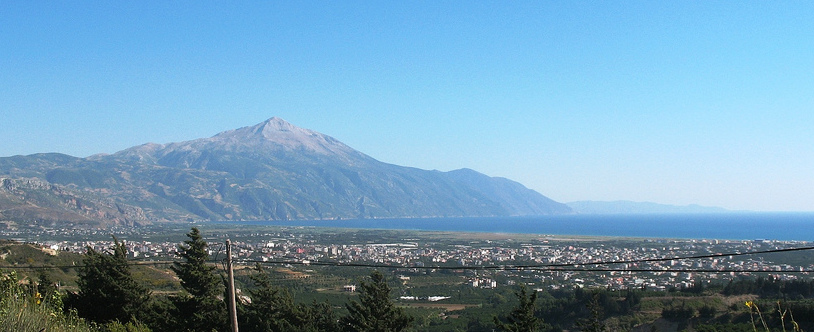 Mount Casius, the sacred home of Ba‘al Hadad–Zeus in Ugaritic mythology as well as in Hellenistic cult.
(Modification of an image by Anthiok, Creative Commons licence)
Mount Casius, the sacred home of Ba‘al Hadad–Zeus in Ugaritic mythology as well as in Hellenistic cult.
(Modification of an image by Anthiok, Creative Commons licence)
In Ugaritic mythology, Ba‘al Hadad becomes king of the gods, but only after he overcomes his brother Yam (god of the sea) and then his other brother Mot (lord of the dead). The latter had taken exception to Ba‘al’s defeat of the serpent Lotan[6]—an echo, perhaps, of the fight between Tarhun and the illuyanka.... Ugaritic mythology recognizes
Mount Casius (Mont Hazi or Mont Ṣapān) as the sacred home of Ba‘al Hadad, which is confirmed by Akkadian and Hebrew texts; thus the god is also identified as
Zeus Casios and Ba‘al Ṣapān.[7] Mount Casius is some 200 km from Doliche, near the mouth of the Orontes (today it is known as Keldağ in Turkish and Djebel el-Aqra‘ in Arabic). Many would go there to pray to the god and receive his counsel in a vision; among the princes who made this pilgrimage were Seleucus Nicator, the divine Hadrian and the divine Julian.
Another key place in the cult of Ba‘al Hadad is Heliopolis or Baalbek in Lebanon, the site of a prestigious temple of Ba‘al Hadad.
Certain Roman inscriptions in honour of Jupiter Optimus Maximus recognize his relationship, or even his identity, with this god who was worshipped as Jupiter Optimus Maximus Heliopolitanus.... We shall say more of this below.
Alongside Tarhun/Ba‘al Hadad is a formidable consort. For the Hittites, this was the sun-goddess of Arinna (the leading goddess of that nation), whom the Hittite queen Puduhepa salutes as
“queen of all lands!
In the land of Ḫatti you have assumed the name Sun-Goddess of Arinna, but in respect to the land which you have made (the land) of cedars (that is, Syria), you have assumed the name of Ḫebat”
(Hebat being a Hurrian mother-goddess).[8]
The usual companion of Ba‘al Hadad was Atargatis,[9] an important goddess also known as Derceto who can be recognized by her depiction, at times, with the body of a fish. Her major sanctuary was at Hierapolis Bambyce (90 km northeast of Aleppo and 100 km southeast of Doliche). She was the deity of whom Lucian of Samosata wrote at length in his work De deá Syriá.
It is therefore only to be expected that we find Jupiter Dolichenus (who is Teshub/Hadad in a Romanized form) accompanied by a high-profile goddess; she, in the event, is called Juno Regina (Dolichena).
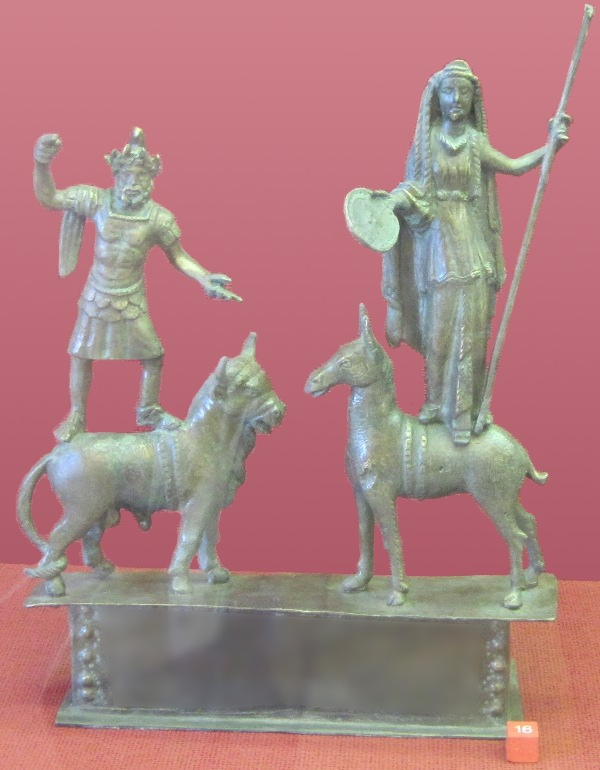 Statuette of Jupiter Dolichenus (left) standing on his bull and Juno Regina (right) on her doe. Jupiter’s double-headed axe and thunderbolt have disappeared, but there still remain Juno’s sceptre and mirror (unless the latter is a
Statuette of Jupiter Dolichenus (left) standing on his bull and Juno Regina (right) on her doe. Jupiter’s double-headed axe and thunderbolt have disappeared, but there still remain Juno’s sceptre and mirror (unless the latter is a patera
). (It may be noted that Juno’s animal—traditionally identified as a doe—almost resembles a camel or even a donkey. The hooves, however, are clearly cloven.)
(Römisch-Germanisches Zentralmuseum, Mainz)
Depiction
Jupiter Dolichenus is depicted in the military finery of an imperator, with decorated armour, the ægis, and sometimes a sword on his belt. However, his distinctive attributes are the labrys or double-headed axe (which he holds in his right hand) and the thunderbolt. The thunderbolt, while characteristic of the classical Jupiter, also recalls the Hittite storm-god.
The most unusual element of his depiction is the fact that he normally stands upon the back of a bull. The bull also is closely associated with Tarhun; there may furthermore be a connection here with Ba‘al Hadad’s foster father El, the Semitic Cronus who is addressed in Ugaritic mythology as “the Bull”[6] (and who was to become the God of Abraham, or God the Father to the Christians). Despite Jupiter’s evident superiority over the bull, they seem to get along well—there is no sign of the violence of the tauroctony, the emblematic cultic scene of Mithras.
As is usual in representations of Jupiter, he is depicted as a mature man, bearded and self-assured. In contrast to his classical guise, however, Jupiter Dolichenus normally wears a Phrygian cap and trousers, which highlight his ‘oriental’ origins.[2]
Much as the Capitoline Jupiter is accompanied by
Juno Regina, the Jupiter of Doliche has his own consort—also called
Juno Regina in inscriptions.
The iconography and character of Juno Dolichena differ appreciably from those of her Near Eastern precursors. Gone are the fish and doves of Derceto; gone, too, is any hint of the orgiastic rites or self-castration practised in honour of the Syrian goddess at Hierapolis Bambyce. Rather, Juno Dolichena comports herself modestly by her husband’s side.
(Nash-Williams attributes the sobriety of the cult of Jupiter and Juno Dolicheni to the relative austerity inherited from Hittite religion.[10])
Clad in a long gown, she holds a mirror in her right hand and a scepter in her left. Unlike Hebat, who relishes the company of lions, Juno Dolichena stands atop a doe. This posture parallels that of her consort with respect to the bull.
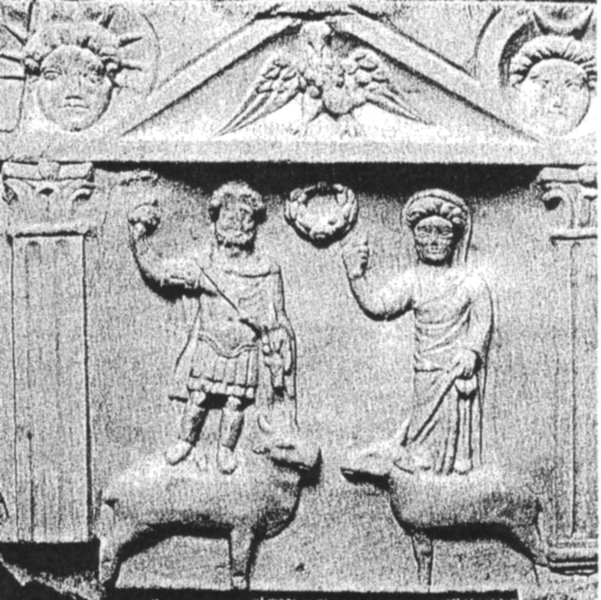 Relief discovered in 1869 in the ruins of the castle of Waisenberg in the present-day state of Carinthia. The divine couple stand on their preferred steeds: a bull for Jupiter and a doe for Juno. Around them are to be seen the Sun, the Moon and the celestial Eagle.
(Modification of an image by Willi04, Creative Commons licence)
Relief discovered in 1869 in the ruins of the castle of Waisenberg in the present-day state of Carinthia. The divine couple stand on their preferred steeds: a bull for Jupiter and a doe for Juno. Around them are to be seen the Sun, the Moon and the celestial Eagle.
(Modification of an image by Willi04, Creative Commons licence)
Complementing the images of Jupiter and Juno Dolicheni are those of two cosmic deities, Sol and Luna, who are typically found in the two upper corners of a Dolichene scene. The Sun god can be recognized by his radiate crown, while the horns of a crescent identify the Moon goddess. There is also a third figure closely linked to these, namelythe celestial Eagle. A motif common to classical and Near Eastern iconography, Jupiter’s Eagle often carries the thunderbolt in his claws; through its speed, far-sightedness and precipitate violence, it symbolizes “the power of heaven”.[11] It is, moreover, on his wings that the divinized soul ascends to heaven.
A pair of male figures often appears in Dolichene imagery. These are the Castores, depicted either as the classical Dioscuri (i.e. Castor and Pollux, twin boxers leading horses, armed with spears and wearing Phrygian caps) or else almost like caryatids, pillars in human form. P. Merlat characterizes the Castores as “stabilizing pillar gods” who symbolize the two hemispheres of the celestial sphere.[12] They can be seen in the Heddernheim plaque
below.
The Mysteries
Worshippers of Jupiter of Doliche would gather to take part in a series of ceremonies, no doubt theurgical in nature, that progressed along with the successive stages of initiation. We shall indulge in some speculation below on the possible scope of the mysteries.
I will say here that if the Dolichene mysteries dealt with the Near Eastern mythological cycles—the successful battles against the serpent, the god of the Underworld, etc.—these themes would presumably have belonged to the lower or intermediate initiatory degrees and would have been presented as possessing an esoteric meaning. Exoteric imagery does depict Jupiter Dolichenus armed with an axe and clad in armour, but there is never any trace, I believe, of his enemy.
Apart from the secrets that initiates received in the course of their regular work with the mysteries, the god would also reveal his will in dreams. Many inscriptions record religious acts undertaken ex uisu (because of a vision) or ex iussu dei (by order of the god).[13]
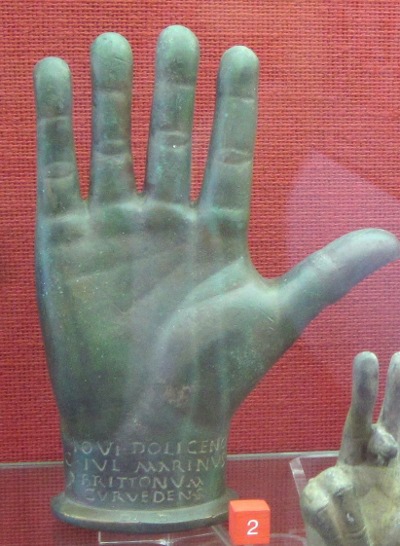 Bronze image of an open hand, a votive symbol of the god’s omnipresent work and blessings. The dedicant, according to the inscription, was a centurion of the Brittones Guruedenses. Heddernheim, first half of the 3rd century.
(Römisch-Germanisches Zentralmuseum, Mainz)
Bronze image of an open hand, a votive symbol of the god’s omnipresent work and blessings. The dedicant, according to the inscription, was a centurion of the Brittones Guruedenses. Heddernheim, first half of the 3rd century.
(Römisch-Germanisches Zentralmuseum, Mainz)
As is typical of initiatory mysteries, the cult of Jupiter Dolichenus was organized hierarchically. Nash-Williams identifies the degrees of the initiates (who called each other fratres or ‘brothers’), from highest to lowest, as follows:
notarius or scriba (scribe), pater candidatorum (father of the ‘candidates’), patroni and sacerdotes (patrons and priests), candidati (candidates), principes huius loci (princes of this [that] place), curator templi (sacristan), lecticarii dei (bearers [of the image] of the god), and colitores (ordinary worshippers).[13] Some of these positions, however, must have been specialized offices (priest, sacristan, bearer of the god) rather than initiatory degrees.
The Dolichene cult is thought to have first been introduced by Syrian merchants and auxiliary soldiers, including troops from Commagene (the province that includes Doliche). It then spread among numerous units of the Roman army all along the Danube, the Germanic limes (notably in Germania Superior) and Hadrian’s Wall. (In Britain, it is thought to have been of even greater popularity than the cult of Mithras.)[10]
V. E. Nash-Williams avers that the devotees of Jupiter Dolichenus belonged to the lower ranks of the army: We find few high officers or great officials of the imperial bureaucracy (in contrast to the cult of Mithras, for example).[1] Civilians worshipped him as well. Outside of Pannonia and Noricum, the greatest number of inscriptions in his honour were to be found in Rome itself.[14]
The temples built in honour of Jupiter Dolichenus were often small, but with richly decorated interior chapels and sometimes with triclinia where devotees could share a feast with the god. Temple equipment included basins and sometimes wells, bells or gongs, and lamps.[13]
Nash-Williams identifies six types of offerings to Jupiter of Doliche: sculptures; figurines (which could depict other divinities as well; he mentions Diana, Apollo and Silvanus); stylized silver representations of lilies (the flower sacred to the Dolichene god, which also resembled Hittite depictions of the thunderbolt); open right hands in bronze; and stone tablets inscribed with the letters of the alphabet.[15]
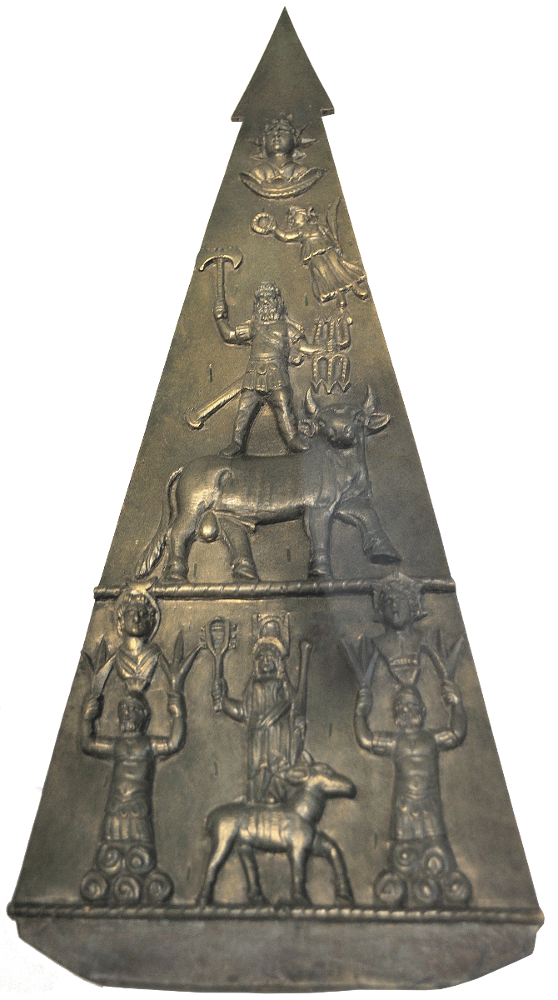 A metal plaque—a characteristic votive offering of the Dolichene worshippers—found at Heddernheim. The god, on the back of the bull, is armed with a double-headed axe, thunderbolt and sword; a winged Victory presents him with a laurel crown while the Sun God shines above. Below is Juno of Doliche standing on her doe, flanked by the Castores, Moon and Sun. Juno wears an Isiac headdress and carries a sistrum—both are emblems of Isis.
(Römermuseum Osterburken ; modification of an image by DerHexer, CC BY-SA 3.0 licence)
A metal plaque—a characteristic votive offering of the Dolichene worshippers—found at Heddernheim. The god, on the back of the bull, is armed with a double-headed axe, thunderbolt and sword; a winged Victory presents him with a laurel crown while the Sun God shines above. Below is Juno of Doliche standing on her doe, flanked by the Castores, Moon and Sun. Juno wears an Isiac headdress and carries a sistrum—both are emblems of Isis.
(Römermuseum Osterburken ; modification of an image by DerHexer, CC BY-SA 3.0 licence)
The deities of the other oriental mysteries could also be found within the
cult of Jupiter Dolichenus. There was even perhaps some effort to supplant these other cults by absorbing their gods.[16] The temples of the Dolichene god are often located in the vicinity of mithræa;[13] inscriptions often invoke Sol Invictus alongside the Syrian god;[14] at times, Juno Dolichena, for example, wields the distinctive attributes of
Isis (see the Heddernheim plaque at left).
P. Merlat presents the evidence of monuments from Rome and Heddernheim as signs of a syncretism aimed at encompassing the popular deities Serapis and Isis within the Dolichene cult.[16]
My interpretation of what all this means differs somewhat from Merlat’s. According to that author,the Sun and Moon represent “eternity”; I should say rather “long-lastingness” (with reference to time that we can measure by the days and years of the Sun as well as by the months of the Moon). By contrast, eternity is a concept that transcends time: Three equals three eternally, without reference to season or circumstance. If we agree with Merlat that the Castores represent space (they appear as the twin pillars of the world’s two hemispheres),[12] we then have symbols of both time and space. For his part, Jupiter Dolichenus is master of eternity and preserver of the cosmos; he thus is naturally surrounded by the symbols of what belongs to him. I imagine that Silvanus, in this schema, evokes space as well, while Apollo and Diana respectively recall the Sun and Moon. Mithras represents the ‘space’, so to speak, that extends beyond the universe. (Both he and closely allied the Sun god may have held special significance as prime agents of Jupiter Dolichenus’ plans.) What then is the role of Serapis and Isis in this iconography? I suggest that it is similar to that of the Eagle. Merlat interprets this to be a symbol of “the power of heaven”, but for Romans of the Imperial age, it would more specifically suggest immortality. The soul, we should recall, ascends to heaven on the back of an eagle during apotheosis. Meanwhile, the mythical cycle of Serapis and Isis centres crucially on the themes of life, death and resurrection. We should not be surprised, then to find a Dolichene depiction of Serapis and Isis showing them on the back of the Eagle (Merlat’s figure 1). Within Dolichene iconography, we thus see time, space, life and death. All this, in sum, is reconciled in Jupiter Dolichenus, who surpasses it all.
Inscriptions
Inscriptions reveal a cult closely, though not exclusively, linked with the Roman army. It was thus most active in the Germanies, the provinces dominated by the legions. Although we find only 3 inscriptions in Germania Inferior, two of them attest the restitution of temples (at Cologne and Xanten) while the third was dedicated by a priest of Dolichenus at Rigomagus.
The Dolichene mysteries were well established in Germania Superior, where we find clusters of inscriptions at Stockstadt-am-Main, Heddernheim and Mainz (for a total of 30 inscriptions in the province). Among the soldiers there are Syrians, but also a British centurion, several Aquitanians, and Rhætians. Most monuments that specify the year of their dedication date from the time of Commodus and the Severans.
The other Gallic provinces yield only 4 Dolichene inscriptions (2 in Gallia Belgica and 2 in Gallia Narbonensis); at Tongres, we find one dedicated by a woman.[14] Though the cult of Jupiter of Doliche is dominated by men—thanks in part to its diffusion in the army—it clearly does not exclude women.
Many inscriptions link the Dolichene cult with the “honour of the divine house” (which is to say the imperial family) or pray for the well-being of such-and-such an emperor. We may cite an example from Great Britain, where a centurion fulfils his vow “to Jupiter Optimus [Maximus
Dolic]henus and to the numina of the Augusti, for the well-being of Emperor Cæsar T. Ælius Hadrianus Antoninus Augustus Pius, father of the country, and” also for the well-being “of the Legio II Augusta”.[17] Such expressions of patriotism, loyalty and esprit de corps are very typical of military inscriptions in favour of the god of Doliche.
We find 23 Dolichene inscriptions in Great Britain. There is one more from Corbridge that piques our interest. A centurion from the Legio VI—on the god’s orders—sets up an altar “to the Eternal Dolichene Jupiter” as well as, lower down, “to the heavenly Brigantia and Salus”.[18] Here is a striking example of the kinds of cultural and cultic contacts that were possible in the polytheistic Roman Empire: On instructions from a god from Commagene, a single altar honours at one and the same time that god, a native British goddess and another goddess who is quintessentially Roman.
Let us finally note that one of the Roman army units where the Dolichene cult took root outside of Gaul was a largely Gallic cavalry corps, the Equites Singulares Augusti or Emperor’s Own Horse Guard. They left 3 inscriptions at Rome relevant to the Dolichene cult, one of which records the dedication of a shrine (aedicula) with a banquet hall (triclinium); another (a low relief) was dedicated to Sol Invictus by a priest of the Dolichene god.[19]
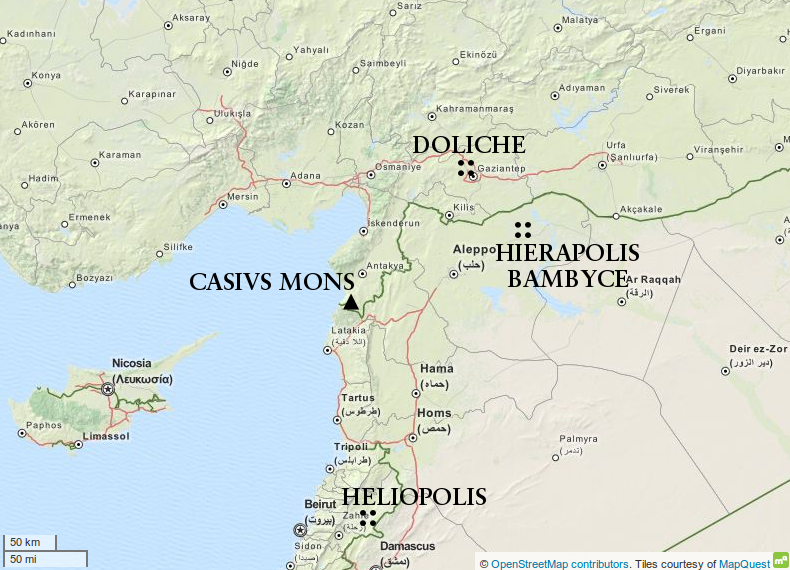 Geography of Jupiter Dolichenus: the great sanctuaries of Doliche (north) and Heliopolis (south) are roughly equidistant from the god’s home on Mount Casius. As for the consort of the god, her great sanctuary was at Hierapolis Bambyce.
(© OpenStreetMap contributors, Open Database License, CC BY-SA)
Geography of Jupiter Dolichenus: the great sanctuaries of Doliche (north) and Heliopolis (south) are roughly equidistant from the god’s home on Mount Casius. As for the consort of the god, her great sanctuary was at Hierapolis Bambyce.
(© OpenStreetMap contributors, Open Database License, CC BY-SA)
Even as the cult of Jupiter Dolichenus spread to the farthest reaches of the West, the East remained attached instead to Jupiter Heliopolitanus.[14] This was a Lebanese form of Ba‘al Hadad (in whom we should therefore expect to find Semitic characteristics without Hittite/Hurrian syncretism). In Gaul, Germany and Britain, I find 3 inscriptions in honour of Jupiter Heliopolitanus (which testifies to his weak diffusion outside the East). The one at Nîmes furnishes us with the most details: The dedicant is a Roman citizen from the household of a first-spear centurion from Beirut. He has fulfilled his vow to Jupiter Optimus Maximus Heliopolitanus—and also to Nemausus, the titular god of the city.[20] Here is another example of the juxtaposition of an oriental cult with a Celtic deity. The Gallic god to whom the city belongs can encounter the Semitic god of the dedicant’s native land, with no jealousy or confusion; they even seem to have collaborated in the matter of this vow (whatever its nature may have been).
Although the British inscription to Jupiter Heliopolitanus tells us little, that of Germania Superior may also preserve the memory of a similarly interesting cultural encounter. The inscription comes from Zellhausen in today’s Hesse. The dedicants are a group of people belonging to the household of an officer (the praefectus cohortis I Aquitanorum); not all are Roman citizens. The deities honoured are Jupiter Optimus Maximus Heliopolitanus, Venus Felix and Mercury Augustus. The location is Germanic; the people in question evidently have affinities for the Syrian pantheon; most are civilians who are serving an Aquitanian military unit.[21] While the appellation ‘Mercury Augustus’ would hardly be out of place in Lyon, the ensemble of deities recalls the triad worshipped at Baalbek, namely Jupiter–Ba‘al Hadad, ‘Athtart–Venus and a young male god identified with Mercury or occasionally Bacchus.
Conclusions
The names of Mithras and Isis have retained a certain presence in public discourse; even their images remain comparatively familiar. By contrast, Jupiter Dolichenus has been nearly totally forgotten. One practical reason for this is precisely that the Hurrian god has taken the Latin name of one of the most famous Olympian gods. This choice of name may condemn him to widespread confusion (if not obscurity), but it conveys an important theological gesture.
It implies that Teshub, Tarhun, Ba‘al Hadad and Ba‘alshamîn are indeed the names of a Jupiter—king of the gods, heavenly lord of the storm-cloud, god of the eagle—but of a specific Jupiter. As eternal preserver of the universe, hemust be understood to be the most profound of all. The masses may be destined to remain ignorant of his significance, but the mysteries of theurgical union may reveal it to a few. For his devotees, Jupiter has the capacity to preserve the universe because he comprehends and transcends it in himself. His iconography depicts him as master of time and space, life and death—an
eternal hypercosmic god.
The ancient secrets of the cult—received from the Syrians, who inherited them from the Hittites—must lead the faithful into communion with the god in order to transcend in their turn this world of passing phenomena.
References
- 1(a) (b). V. E. Nash-Williams (juin 1952), “Iuppiter Dolichenus”, Greece & Rome, vol. 21, No 62, p. 77.
- 2(a) (b) (c). Nash-Williams (op. cit), p. 72.
- 3. One might speak of hypostases or avatars of Jupiter. These are distinct persons who, at the same time, participate in one and the same nature: that of the absolute Jupiter. Among other hypostases of Jupiter, we may note the Germanic Thor, Jupiter Ammon (Libya’s ram-headed god), Jupiter Capitolinus and Jupiter Tonans (both of whom were worshipped at Rome’s Capitol). In a dream, the divine Augustus once saw Jupiter Capitolinus complain to him that the new temple of Jupiter Tonans would take away from his own worshippers....
(C. Suetonius Tranquillus, “Diuus Augustus” 91, in opera De Vita XII Caesarum).
- 4. In the 7th century, Doliche was overtaken by the nearby town of Ayıntap, which absorbed many of its inhabitants. It is thus the Turkish city of Antep (now also known as Gaziantep) that assumes the legacy of Doliche as well as its role as a commercial crossroads between Syria and Anatolia (Gaziantep Kültür ve Turizm Müdürlüğü, “Dülük Antik Kenti”). The site of Dülük lies today within the metropolitan boundaries of Gaziantep.
- 5. Text transliterated and translated into English by Gary Beckman (January 1982), “The Anatolian Myth of Illuyanka”, Journal of the Ancient Near Eastern Society.
- 6(a) (b). The “Cycle of Ba‘al” (Ugaritic texts; English translation).
- 7. Jewish Virtual Library/Encyclopedia Judaica (2008), “Baal Worship”.
- 8. Gary Beckman (June–September 1989), “The Religion of the Hittites”, The Biblical Archaeologist 52.2/3, pp. 99-100.
- 9. In Semitic sources, Anath and ‘Athtart are closely linked with Ba‘al Hadad. They might both have been considered his wives, at least in some places; for its part, the “Cycle of Ba‘al” (op. cit.) considers Anath the god’s virgin sister.
- 10(a) (b). Nash-Williams (op. cit), p. 73.
- 11. P. Merlat (January–June 1947), “Jupiter Dolichenus, Sérapis et Isis”, Revue archéologique, 6e série, vol. 27, p. 19. The original phrase is “la puissance céleste”.
- 12(a) (b). P. Merlat (op. cit.), pp. 15–17. In the original, “dieux-piliers stabilisateurs”.
- 13(a) (b) (c) (d). Nash-Williams (op. cit), p. 76.
- 14(a) (b) (c) (d). Please see the list of inscriptions (plain-text format) drawn from the Epigraphik-Datenbank Clauss/Slaby.
- 15. Nash-Williams (op. cit), pp. 74–75.
- 16. P. Merlat (op. cit.), pp. 10–31.
- 17. This inscription is from Condercum in the present-day city of Newcastle upon Tyne. The Roman Inscriptions of Britain (RIB) 1, 1330.
- 18. RIB 01, 02158.
- 19.
Corpus Inscriptionum Latinarum (CIL) VI, 30931 ; CIL VI, 31181.
- 20. CIL XII, 3072.
- 21. CIL XIII, 6658.

En français svp !

Auf deutsch, bitte!
DEO ·
MERCVRIO · CETERISQ · DIIS · DEABVSQ ·
IMMORTALIBVS · VIDVCVS · BRIGANTICI · F ·
ANNO · POST · R · C · MMDCCLXVII ·
V · S · L · M









